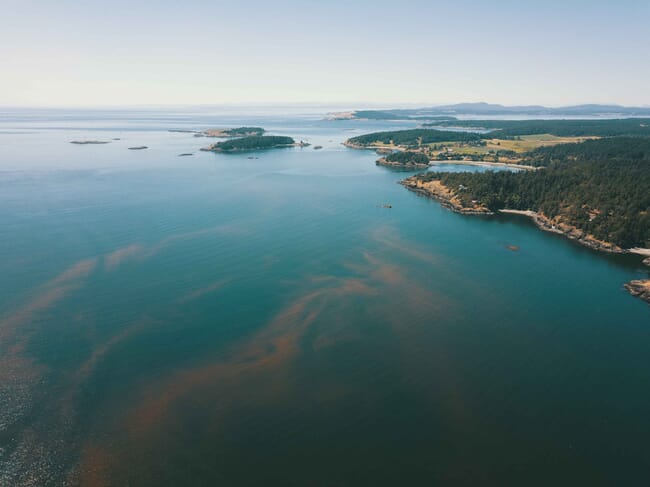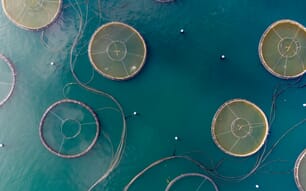
Not all algae are harmful to farmed salmon and new technology is helping farmers to identify threats to their fish sooner © SAIC
HABs occur when microscopic algae populations grow, amplified by environmental factors and weather conditions, to form blooms. They can be particularly problematic for gill health and, with global temperatures rising, are becoming a more prevalent challenge for Scottish seafood producers.
Compared to salmon producing countries such as Chile and Canada, HABs in Scotland are typically less frequent but also more difficult to predict. The increased demand for monitoring and early warning systems reflects the sector’s ambition to mitigate the potential impacts of climate change, particularly any issues that could impact fish health.
Many producers are still using manual water quality sampling and microscopic analysis to detect whether HABs are present, but industry and experts agree that a greater focus on technology could hold the key to regular, real-time data collection and the development of early warning systems.
“HABs events are difficult to predict, but with regular monitoring, potential negative consequences can be managed and mitigated. One of the biggest priorities for farmers is caring for fish in the best ways possible, using all the tools and technologies available to them, such as monitoring procedures that make it quick and simple to identify risks," said Debra Brennan, fish health laboratory manager at Mowi, in a press release.
“We currently use an image-based process for identifying different species, with health team members on hand to support with action plans as required. The process needs to be as user-friendly as possible, but we could use new technology to our advantage to support that and enable us to take early action to protect fish from potential harm,” she added.
Marine technology developer OTAQ is among a number of businesses in the aquaculture supply chain already looking at how the process of identifying and predicting HABs could be digitised. The company’s early warning system is expected to reach the commercial market later this year and uses a combination of artificial intelligence (AI), sensor technology, and digital microscopy to help identify potential issues accurately and quickly.
Chris Hyde, chief technology officer at OTAQ, said: “Our goal is to automate the process of identifying harmful phytoplankton, allowing fish farmers to take action to protect their fish as early as possible. Workers on site might have a range of different abilities when it comes to recognising different species, but a combination of real-time, 24/7 data and digital image analysis will enable producers to prevent threats to welfare and reduce losses.
“AI is a growing area of interest for marine operations, particularly in aquaculture, and this system will demonstrate the potential impact that advanced technology can have for the sector, in this case protecting stocks and minimising the health risks associated with HABs.”
Sensing technology and mitigation tools were core themes of the discussions at the Global HAB Workshop: Industry Perspectives hosted by the Sustainable Aquaculture Innovation Centre (SAIC) earlier this month – part of a wider event organised by the University of Strathclyde, University of Glasgow and the Scottish Association for Marine Science (SAMS) – which saw sector experts share insights about the impact of HABs. Mitigation techniques were also discussed, such as amends to feeding regimes, clean water upwelling, oxygenation systems and bubble curtains.
SAIC has also supported several collaborative initiatives looking at managing the impact of HABs, including the development work behind OTAQ’s live plankton analysis system through funding provided to the University of Aberdeen; this was Scotland’s first project funded by both SAIC and CENSIS (Scotland’s innovation centre for sensing, imaging and Internet of Things technologies).
Sarah Riddle, director of innovation and engagement at SAIC, said: “In dealing with HABs, early warning is key – having even a few hours’ notice, so that a robust mitigation programme can be put in place, can make a big difference to fish health. There are still challenges to overcome in adopting new technology, including digital connectivity at remote sites and the ability to handle and analyse vast amounts of data, but there are significant opportunities for producers to use technology and innovative mitigation tools to protect fish.
“Collaboration and knowledge sharing is crucial to helping the sector expand its economic impact while reducing its environmental footprint, and that will only become more important as the occurrence of HABs increases. SAIC enables accelerated dissemination of new approaches, underpinned by the Farmed Fish Health Framework, drawing on the latest knowledge available in Scotland, as well as from our network of international contacts.
“We hope that the Global HAB Workshop will lead to further practical innovation that will be of use to the sector both in Scotland and globally.”




